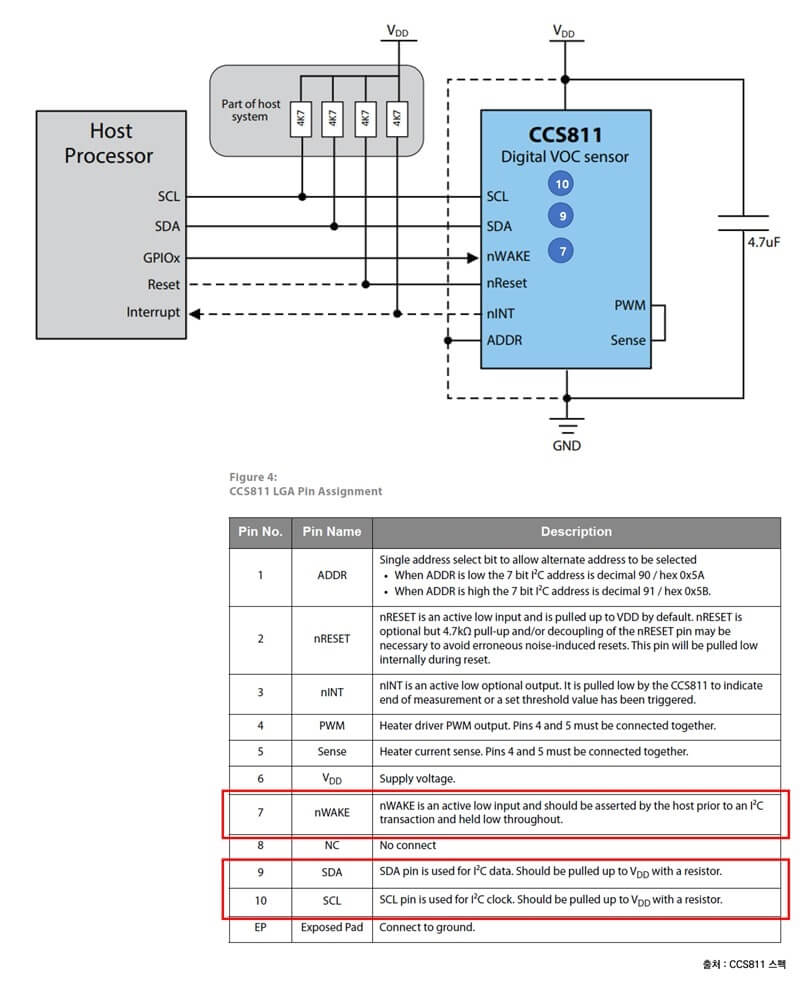This chapter explains how to use the CCS811 sensor. You will learn its features, operating principles, specifications, connection pin arrangement, output values, and connect Arduino and the sensor together to measure the air around you easily using the library.
Contents
CCS811 TVOC Sensor

According to the Indoor Air Quality Management Act Enforcement Regulations and Indoor Air Quality Recommendation Standards (related to Article 4), TVOC is classified into recommended standards along with nitrogen dioxide, radon, asbestos, and ozone. The definition of TVOC is determined in the environmental pollution process test standard in Article 6, Paragraph 1, Subparagraph 3 of the [Environmental Test and Inspection Act].
Atopic dermatitis caused by indoor pollution is a chronic inflammatory skin disease that occurs mainly in childhood, causing severe itching for a long period of time, leading to a decrease in quality of life, and an increase in economic burden. In a long-term study of changes in symptoms and concentration of air pollutants in patients with atopic dermatitis, VOCs worsened the symptoms of atopic dermatitis. There are thousands of substances corresponding to VOCs, and more than 900 are identified in the indoor environment. Representative examples include benzene, formaldehyde, toluene, xylene, ethylene, styrene, and acetaldehyde.
In Korea, 37 types of volatile organic compounds subject to management are announced [] in accordance with Article 2, No. 10 of the Air Conservation Act. Even if the temperature decreases, VOCs that have already been released in the air do not disappear.
VOCs have a boiling point between 50 and 100 ℃ and between 240 and 260 ℃, they can exist as liquids, solids, as well as gases. Since its state is related to the boiling temperature, the concentration may vary depending on the room temperature. That is, the higher the temperature, the more VOCs can be released. VOCs are discharged from factories, petroleum manufacturing, gas stations, laundry, printing shops, automobiles, aircraft, ships, various household goods, decorations and construction materials.
Effects on the human body
TVOC (Total Volatile Organic Compounds) can be very dangerous indoors if the windows are closed, and an air purifier is running. TVOC adversely affects the human body depending on its type (degree of toxicity), concentration and duration of exposure. It is carcinogenic and causes nervous system disorders through skin contact or respiratory inhalation.
Depending on the type (degree of toxicity), concentration and duration of exposure to TVOC, it can have adverse effects on human health. VOCs mainly cause irritation of the respiratory tract, headaches and neurophysiological dysfunction. The concentration at which a direct effect on the human body appears or the degree of reaction of the human body to contaminants varies greatly depending on the individual. Therefore, contamination characteristics of indoor VOCs substances should not be based on only one person indoors complaining of discomfort with these substances.
There are many VOCs in the air that do not affect health, but there are also toxic VOCs. 1,2-dichloroethane, benzene, carbon tetrachloride, formaldehyde, styrene, tetrachloroethylene, and xylene that are among the most dangerous VOCs known today, according to the Centers for Disease Control and Prevention (CDC). In addition, 37 VOCs announced by the Ministry of Environment are [hazardous and harmful to humans].
It has carcinogenic properties and causes nervous system disorders through skin contact or respiratory inhalation. Short-term exposure to high levels of VOCs can cause headache, dizziness, dizziness, drowsiness, nausea, eye and respiratory irritation, and allergic reactions. The concentrations that have a direct effect on the human body or the degree of reaction of the human body to contaminants vary greatly from individual to individual. In addition, long-term exposure to high levels of VOC in animal laboratories has been shown to cause cancer, affect the liver, kidney, and nervous system.
CCS811 Sensor?
AMS' CCS811 integrates a metal oxide (MOX) gas sensor to monitor indoor air quality. It consists of a microcontroller unit (MCU) that detects a wide range of volatile organic compounds (VOCs) with a digital gas sensor. The CCS811 sensor's integrated MCU manages the measured sensor drive mode and raw sensor data while detecting VOCs.

[CCS811 sensor specifications ]
CJMCU-811 (CCS811) TVOC sensor operates at 3.3V.

[CCS811 sensor pin arrangement ]
The pin arrangement of the sensor is as follows.

[CCS811 operation principle]
The CCS811 features a metal oxide sensor (MOX) and a small microcontroller that controls the power to the plate, reads the analog voltage and reads it through an I2C interface. It contains a 10K NTC thermistor that matches the equilibrium resistance that can be read from the CCS811 to calculate the approximate temperature.
Like all metal oxide sensors (MOX), the CCS811 measures the resistance of an area exposed to the surrounding air. This area is heated up to several hundred ºC with a heater element (resistance) and some oxidation reactions occur. The nature of the measurement area, exposure time to various chemical components, and ambient conditions varies from sensor to sensor. For this reason, individual sensor characteristics are very complicated, and relative measurements use internal processing to monitor the reference resistance of the sensor (i.e. the resistance of the sensitive layer when exposed to clean air). Sensors typically target contaminants that can be oxidized on the sensor substrate. This oxidation process changes the resistance of the sensor, and the more oxidation reactions, the lower the resistance. The concept of reference resistance can be confusing, but basically, the higher the resistance, the cleaner the environment.
Temperature and humidity are used internally to compensate for readings as the sensor compares the actual resistance to the clean air resistance (baseline) and uses ambient conditions during calibration.

Purchasing the CCS811 sensor
As follows, the [CCS811] sensor used in the book [Arduino Sensors for Everyone] can be purchased at Ali Express, Amazon.

Software Coding
Run the example file in Steamedu123_Sensor-master > examples.
/*
@304 CCS811 TVOC sensor
*/
#include <C304_Steam_Air_CCS811_TVOC.h> // Internal library header file
SteamCCS811 ccs811; // Instance, pin number
void setup() {
Serial.begin(9600); // Start serial communication at a speed of 9600bps.
ccs811.begin(); // (1) Initialize the sensor.
}
void loop() {
ccs811.read(); // (2) Measure the value of the sensor.
ccs811.display(); // (3) Output the sensor value.
delay(1000); // Wait for 1 second.
}
CCS811 Arduino sensor operation check
When the hardware connection and software coding are completed, you can check the operation screen as follows.
------------------------------------------------------
Development environment: WINDOWS 10
Arduino IDE: 1.8.13
------------------------------------------------------
01 library copy
You can easily check the operation by using the library.
The libraries \Steamedu123_Sensor-master folder is copied to the folder below.
* This folder is created automatically after installing Arduino C:\Users\s\Documents\Arduino\libraries
02 *. ino file execution
-Connect Arduino and PC
-Run Arduino IDE
-Menu → Tools → Board: Check Arduino UNO
-Menu → Sketch → Check/Compile
03 Check compilation
Select Sketch>OK/Compile (CTRL+R) to compile.
04 Arduino Uno upload
When the compilation is completed without any problems, select Sketch>Upload (CTRL+U) to upload the compiled file.
05 Operation check
You can check the operation as follows.
Wrap-up
You can connect Arduino and [CCS811] sensor and practice the sensor easily with simple coding.
In this section, we investigated the effects of TVOC on the human body, the reference concentration, the measurement range of simple measuring instruments, and the sensors used in measuring instruments, and measured TVOCs directly using the CCS811 sensor and Arduino.
Indoor air with TVOCs has adverse effects on the human body such as irritation in the eyes/nose/throat, shortness of breath, headache, fatigue, nausea, dizziness, skin problems, lung inflammation, and liver/kidney/central nervous system damage.
Since TVOCs cannot be removed with air purifiers, check TVOC levels measured by the CCS811 sensor, and if it is bad or very bad, open a window to allow fresh and clean air to enter the house. In addition, it is recommended to refrain from products with artificial scents such as installed or sprayed fragrances, deodorants, scented candles, and incenses.
References
References for [CCS811 TVOC Sensor] used in the book [Arduino Sensors for Everyone] are as follows.
[57] Naoki Kunugita, Keiichi Arashidani, Investigation of air pollution in large-scale buildings and of employees’ personal exposure level, 2007
[58] Volatile Organic Compounds, Indoor Air Quality and Health, Lars Mølhave, December 1991
[59] WAVERTON ANALYTICS (2016) Survey reports: VOCs and hidden mould, Waverton Analytics Limited, Cheshire,
[60] Ministry of Environment, Indoor Air Quality Management Act Enforcement Regulations, Indoor Air Quality Recommendation Standards (related to Article 4) [Effective date: April 3, 2020
[61] David Fujiwara, “Indoor air quality assessment”, safetech environmental limited, 2014
[62] Ludmila Meciarova, Silvia Vilčeková, Analysis of VOCs in the indoor environment, Engineering Journal of Civil Engineering, Environment and Architecture, 2015
[63] Gabriel Yurko, Real-Time Sensor Response Characteristics of 3 Commercial Metal Oxide Sensors for Detection of BTEX and Chlorinated Aliphatic Hydrocarbon Organic Vapors, 2019,
[64] CCS811 Datasheet,
[65] sensirion_Gas_Sensors_Datasheet_SGP30,
[66] Aliexpress CCS811,
[67] Aliexpress SGP30,
[68] Aliexpress TGS2602,
[69] Ams Homepage,
[70] Adafruit CCS811,
[71] SparkFun CCS811
{72] Ams Homepage,
[73] CCS811-Datasheet, “Pin Assignment”, p3
[74] Smart Citizen Docs, eCO2 and TVOC sensor,
[75] Comparison of CO2 sensors MH-Z19B and CCS811,
[76] Quinnell, R., Siloxane-resistant MOX gas sensor brings smartphones one step closer to Star Trek’s tricorder. Electronic Products Magazine, 2017
[77] WAVERTON ANALYTICS, Survey reports: VOCs and hidden mould, Waverton Analytics Limited, Cheshire,
[78] David Fujiwara, “Indoor air quality assessment”, safetech environmental limited, 2014
[79] Humai (HI -150A),
[80] Koamise S3,
[81] Airram (SAP-500H),
[82] Lisa Home (IAQM3000),
[83] AO ((EG-AO-V10),
Purchasing a book
[Arduino Sensors for Everyone] The book is available for purchase on Google Book and Apple Books.
In this book, you will learn how to use the PMS7003, GP2Y1010AU0F, PPD42NS, SDS011 Fine Dust Sensor, DHT22 temperature/humidity sensor, MH-Z19B carbon dioxide sensor, ZE08-CH2O formaldehyde sensor, CCS811 total volatile organic compound (TVOC) sensor , GDK101 radiation (gamma ray) sensor, MQ-131 ozone (O3) sensor, MQ-7 carbon monoxide sensor, MICS-4514 nitrogen dioxide sensor, MICS-6814 ammonia sensor, DGS-SO2 sulfur dioxide (SO2) sensor, BME280 atmospheric pressure sensor, GUVA-S12SD ultraviolet (UV) sensor, MD0550 airflow sensor, and QS-FS01 wind speed sensor.
Arduino Sensors for Everyone, 저자: Ronnie Kim - Google Play 도서
Arduino Sensors for Everyone - 저자가 Ronnie Kim인 eBook입니다. PC, Android, iOS 기기에서 Google Play 북 앱을 사용해 이 책을 읽어 보세요. 책을 다운로드하여 오프라인으로 읽거나 Arduino Sensors for Everyone을(를)
play.google.com

'Arduino Sensors > Chapter 3 Indoor air environmental senso' 카테고리의 다른 글
| GDK101 Radiation Sensor [Arduino Sensors for Everyone] (0) | 2021.06.13 |
|---|---|
| ZE08-CH2O Formaldehyde Gas Sensor [Arduino Sensors for Everyone] (0) | 2021.06.12 |
| MH-Z19B Carbon Dioxide Gas Sensor [Arduino Sensors for Everyone] (0) | 2021.06.12 |
| DHT22 Temperature-Humidity Sensor [Arduino Sensors for Everyone] (0) | 2021.06.12 |





댓글